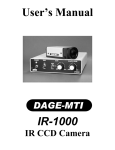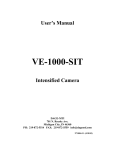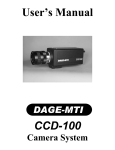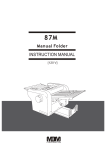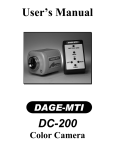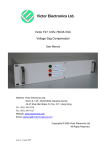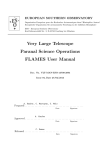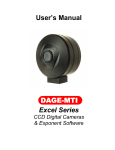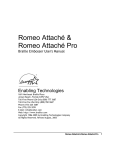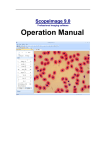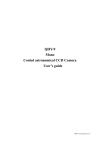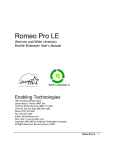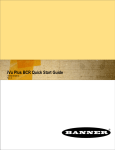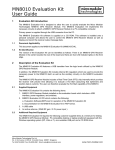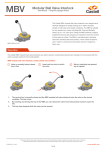Download User`s Manual
Transcript
User’s Manual DAGE-MTI CCD300-RC CCD Camera System Purchaser’s Record Model Name: DAGE-MTI CCD300-RC Serial Number: Dealer’s Name: Dealer’s Address: Dealer’s Phone Number: Date Purchased: P.O. Number: Introduction The DAGE-MTI CCD300-RC camera system is based upon a 1/2" Interline CCD that produces high-resolution imaging. The CCD employs a state of the art microlens design to increase the light gathering capability of the CCD. The simplistic front panel design of the RC-300 control unit allows easy access to both Gain and Black Level. The Gain, Black Level and Gating can also be remote controlled via the RS-232 serial interface. The read-out of the sensor can be inhibited by an external pulse, which allows increased integration times in low-light level situations. The camera head can be optionally configured with a thermoelectric cooler to allow even longer integration times without annoying artifacts. The versatility of the DAGE-MTI CCD300-RC camera system makes it the camera of choice in almost any imaging situation. DAGE-MTI offers our customers state-of-the-art video technology… with an eye on your image. Installation The cooled or uncooled CCD-300 camera head connects directly into the RC-300 control unit. Power for the control is supplied by an external switching supply that is provided. Ensure that a correct AC power cord is used in accordance with local safety standards. All power and interconnections to the CCD-300 camera head are supplied through the single interface cable. Gating can be accomplished by simply using the DAGE-MTI Investigater to control the gate time, display and store the image, or by using a computer with a frame grabber. If a computer is used, there are two methods of gating available. (1) Have the computer/frame grabber supply the gating signal to the RC-300, and grab the gated image. (2) Control the RC-300 via the RS-232 interface and have the camera internally control the gate time and supply an index pulse to the frame grabber for acquisition. Figure 1 shows some typical setups of the CCD300-RC. INVESTIGATER CONTROL UNIT VID OUT VID IN MONITOR 2 GATE COMPUTER 3 RC-300 CCD CAMERA CONTROL RS232 AUX VID CAMERA 1 CCD-300 HEAD POWER POWER CORD POWER SUPPLY 1. RC-300 VID OUT CONNECTED TO MONITOR. CAMERA OPERATION IN ‘NON GATING’ REAL TIME MODE. 2. RC-300 CONNECTED TO INVESTIGATER CONTROL UNIT. GATING AND FRAME STORE OPERATION CONTROLLED BY INVESTIGATER CONTROL UNIT. 3. RC-300 CONNECTED TO A COMPUTER. GATING AND FRAME STORE OPERATION CONTROLLED BY COMPUTER. Figure 1: CCD300-RC Connections Figure 2: RC-300 Rear Panel Power Connect the external switching supply to the rear panel's POWER connector and to a suitable power source in the range of 95VAC to 250VAC. Ensure that an approved AC cord is used to attach the supply to the AC mains. Camera This 26-pin ‘High Density D’ connector supplies all of the power and interface to the CCD-300 camera head. Always ensure that the camera head is attached to the RC-300 control unit before turning the control unit on. Aux External drive inputs, gating input and index output are accessible through this connector. An Aux Gating Cable*, Dage P/N 835320-08, can be used to provide input of a gate pulse into the AUX connector via a ‘BNC’ type cable. Connect to a computer or the DAGE-MTI Investigater. Contact DAGE-MTI for optional drive cables or other optional gating cables for connection to various “frame grabbers”. *Included with cooled version, optional with uncooled version of CCD300-RC. RS-232 The RS-232 feature was added to the RC-300 with serial numbers 700 and up. This ‘RJ-11’ connector allows control of the CCD300-RC system via a standard RS-232C serial port. An optional RS-232 Adapter Cable, Dage P/N 207703, is available for interface into a standard 9 pin ‘D’ serial port. The RC-300 requires 9600 baud, 8 bits with 1 stop bit, no parity and is shipped with a 3.5” diskette that provides four versions of a demo program to interface the camera to a ‘PCcompatible’ computer. These four versions include programs for DOS or Windows®, on Comm Port 1 or 2. The demo diskette, Dage P/N 207697, has an ASCII file, RS3_DEMO.txt, which explains the installation and function of the demo software. The text file, RS3_INFO.txt contains all the technical details of the RS-232 commands as well as advice to aid in programming for the camera. Please refer to the diskette’s, RS3_READ.1st, file prior to installation and use of the demo software or beginning to construct a program for controlling the CCD300-RC camera system. Video This ‘BNC’ connector supplies video output of the RC-300. The signal is 1Vp-p terminated into 75Ω. Be careful to avoid double termination of the output video, which would result in incorrect video levels. Connect to a monitor, computer or the DAGE-MTI Investigater as required. Operation 00Figure 3: RC-300 Front Panel Power This switch controls the power to the RC-300. The switch's green light indicates when the power is on. Gain The GAIN of the RC-300 can be either in a fixed or automatic mode. The gain range of the RC-300 is about 20 times (26db). When the control is completely counterclockwise, the detent position places it in the AUTO mode. In this position, the output of the camera is determined by the internal automatic gain control (AGC) circuitry, which will adjust the camera gain in order to keep the output signal at a full level. The remainder of the GAIN control's range is dedicated to the fixed gain mode. At the MIN setting, close to the CCD's full well signal results in a full output video signal. In practice, the entire CCD's dynamic range is not usable. To minimize smear and over-level problems, the CCD's output starts to become compressed at saturated light levels. In order to maximize the range of the CCD without producing compressed results, we set the camera gain slightly below full well potential. When the GAIN control is set at MIN, the camera is in the lowest noise mode. When utilizing gating, the camera should be in this mode. Black Level The output black level of the camera is determined by this control. When in the FIX mode, the output video resides on a standard 50mV black pedestal. The range of the black level control allows blacks to be pulled down such that whites can be contrast enhanced and stretched. The use of this mode while the GAIN control is in AUTO allows the camera to stretch that portion of the signal that is of interest. When using external gating, the black level is useful for removing unwanted light offsets due to effects such as lens scattering and low level background light. Gating The CCD300-RC camera system can be externally gated in order to increase the sensitivity. Inhibiting the readout of the CCD's image allows light to gather in the CCD for extended periods of time. An external gating pulse defines the gate time of the camera through the AUX connector. The Aux Gating Cable, Dage P/N 835320-08, provides a ‘BNC’ type connector for the input of the gate signal. Gating can be accomplished by simply using the DAGE-MTI Investigater, or by using a computer. If a computer is used, follow the timing recommendations as follows. The timing of the External Gate pulse requires that the pulse occur sometime during the field immediately before the CCD readout is to be inhibited. Figure 4 shows the relationship of the CCD transfer to the output video signal. Figure 4: Video to CCD Transfer Timing As long as the gate pulse edges occur before the CCD transfer, the correct timing will occur. Care should be taken to ensure that the CCD is gated for an even number of fields. If an odd number of fields are gated, the resultant image will differ in intensity between the two fields. To inhibit the readout of the CCD, simply ground the CCD Gate pin of the AUX connector. The camera will readout the two fields immediately following the ground release of the CCD Gate pin. The CCD Gate pin is compatible with standard CMOS type logic interfaces. Figure 5: External Gate Timing & Video Readout Another method of gating is to use the RS-232 interface and place the camera into an internal gating mode. The gate time (# of frames) will be selectable by software and the RC-300 will run a continuous or single gating event. In order for the gated frame to be grabbed and displayed, an Index pulse on the AUX connector is provided to trigger a frame grabber. The default* Index pulse is normally high, goes low at the leading edge of vertical sync of the video frame to be grabbed, then goes back high at the next vertical sync. The Index signal is compatible with standard CMOS type logic interfaces. Figure 6 shows the relationship of the Index pulse to the output video signal for a 3 frame continuous gate. * Can be inverted. See 1st note on next page. Figure 6: Index Timing & Video Readout NOTES: The default Index pulse, shown above, can be inverted by placing a jumper inside the RC-300 control at ‘SW1-4’. Contact DAGE-MTI for optional gating cables designed specifically for various frame grabber manufactures. When utilizing gating, the camera’s GAIN control should be set at MIN, to put the camera in the lowest noise mode. External Drives The CCD300-RC camera system can be externally driven with either, a composite sync/video signal, or separate horizontal and vertical drives pulses. Optional drive cables are available to provide the drive pulses into the AUX connector via ‘BNC’ type connections and can still provide the gating capability of the Aux Gating Cable. All drive inputs are terminated with 75Ω and therefore need to be negative going 5V pulses capable of driving 75Ω. Refer to the AUX connector pin-out for additional information. Connector Pin-outs Power 1 3 4 2 5 This 5-pin ‘DIN’ connector receives DC power from the external switching power supply. The supply plugs into an appropriate AC outlet and provides all of the necessary voltages to the RC-300. Pin-out of the POWER Connector is as follows: PIN # 1 2 3 4 5 FUNCTION GND GND +5V Power In (+5VDC @ 750mA) -12V Power In (-12VDC @ 20mA) +12V Power In (+12VDC @ 450mA) NOTE: The external power supply has no user accessible parts. Refer maintenance to a qualified technician. Camera This 26-pin ‘High Density D’ connector supplies all of the power and interface to the cooled CCD camera head. Always ensure that the camera head is attached to the control unit before turning the control unit on. There are no user level connections recommended into this connector. Also, do not alter the cable length or attach cable extensions on this connector without approval from Dage-MTI. Aux 1 2 3 4 5 6 7 8 9 External drive and gating signals to the RC-300 come through this 9-pin male ‘D’ connector. Pin-out of the AUX is as follows: PIN # 1 2 3 4 5 6 7 8 9 FUNCTION CCD Gate In (+5V=Readout; Gnd=Gate) Ext Horz Dr, Sync In, (5V neg going, 75Ω term) or Video In (Comp Vid w/300mV Sync 75Ω term) Ext Vert Dr In (5V neg going, 75Ω term) Index Out* (+5V=Norm; Gnd=Frame to grab) Gate and Index GND Horz Dr GND NC NC Vert Dr GND NOTES: * The default Index Out signal can be inverted by placing a jumper inside the RC-300 control at ‘SW1-4’. The Aux Gating Cable, Dage P/N 835320-08, (included with the cooled version of the CCD300-RC), provides a ‘BNC’ type connector for the ”CCD Gate In” signal. Contact DAGE-MTI for optional drive cables and gating cables designed specifically for various frame grabber manufactures. RS-232 654321 RS-232 control signals to and from the RC-300 come through this 6-pin ‘RJ-11’ modular jack connector. Pin-out of the RS-232 connector is as follows: PIN # 1 2 3 4 5 6 FUNCTION N/C N/C RS-232 Input to RC-300 RS-232 Output to Computer Ground N/C NOTE: An optional RS-232 Adapter and cable, Dage P/N 207703, is available for interface into a standard 9 pin ‘D’ computer serial port. Video The output video of the RC-300 is present at this ‘BNC’ connector. The signal is 1Vp-p terminated into 75Ω. Care should be taken to avoid no termination or double termination of the output video, which would result in incorrect video levels. Specifications: Pick-up Device: Signal to Noise: Shading: 1/2" Interline CCD w/microlens 58.5db (60db cooled) <5% overall Pixel Clock Freq: Vertical Rate: Horizontal Rate: RS-170 768(H) x 494(V) 8.4um(H) x 9.8um(V) 570 TVL (H) 350 TVL (V) 14.318 MHz. 59.94 Hz. 15,734 Hz. CCIR 752(H) x 582(V) 8.6um(H) x 8.3um(V) 561 TVL (H) 405 TVL (V) 14.1875 MHz. 50 Hz. 15,625 Hz. Sensitivity: Full Video (min gain) Full Video (max gain) 20% Video (max gain) w/ IR Filter 0.087 fc. 0.004 fc. 0.0008 fc. w/o IR Filter 0.036 fc. 0.002 fc. 0.0004 fc. Weight: Control Unit Power Supply Cooled Head Uncooled Head 1.48 lb. (0.67 Kg.) 0.75 lb. (0.34 Kg.) 3.03 lb. (1.38 Kg.) 1.01 lb. (0.46 Kg.) Size: Control Unit Power Supply Cooled Head Uncooled Head 5½"(W) x 1½"(H) x 8"(L) 2½"(W) x 1¾"(H) x 4"(L) 4"(W) x 4½"(H) x 4½"(L) 4"(W) x 4½"(H) x 3"(L) Operating Temperature: 0°C to +40°C Input Voltage: 95VAC to 250VAC Active Picture Elements: Picture Element Size: Resolution: Troubleshooting No Picture (Check or try the following): 1. Camera Power On? a. External Power Supply Attached? b. AC Power On? c. LED on Camera Front On? 2. Head Connected to Control? 3. Monitor Connected to Camera Video Output? a. Monitor Power On? 3. Light Level Too Low? a. Open Camera Lens. b. Set Camera into Auto. Picture Saturated: (Check or try the following): 1. Video Output Cable Terminated Into 75Ω? 2. Light Level Too High? a. Reduce Lens Setting. b. Set Camera in Auto. Warranty The DAGE-MTI CCD300-RC is warranted to be free of defects in material and workmanship in normal use for a period of one year from the original date of purchase from DAGE-MTI. This warranty does not apply to units which have been subject to abuse, neglect, accident, improper installation, or on which the serial number has been removed or damaged. Units that have been altered without the prior permission of DAGE-MTI are not covered by this warranty. This warranty does not apply to other equipment furnished by DAGE-MTI, which is listed or otherwise identified as manufactured by another and therefore shall be covered by the other manufactures’ applicable warranty. Limitations 1. This warranty is valid only if the malfunctioning unit is returned to DAGE-MTI service depot. This warranty does not cover on-location service. If warranty work is needed, the following should be contacted: DAGE-MTI, INC. Customer Service 701 N. Roeske Ave. Michigan City, IN 46360 (219) 872-5514 Fax: (219) 872-5559 [email protected] 2. This warranty does not cover: a. Problems caused by or inflicted upon associated equipment such as digitizing systems, video tape recorders, cameras, microscopes, etc. b. Damage caused by accident, misuse, improper power source, fire, flood, lightning, other acts of God, war, and repair or alteration by other than a DAGE-MTI authorized service organization. c. Labor or incurred charges required in removing or installing the Product, down time, failure of the Product to perform properly, and any consequential damages. d. Transit damage. 3. Unit must be properly packaged (in original packing, if possible) when being returned under warranty. DAGE-MTI Inc. 701 N. Roeske Ave. Michigan City, IN 46360 (219) 872-5514 Fax: (219) 872-5559 E-mail: [email protected] http://www.dagemti.com 970320-11 5/14/02




















